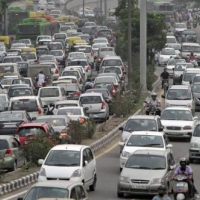India has 13 of the 20 Most Polluted Cities in the World
 Traffic on Delhi's roads (file photo: Reuters)
Traffic on Delhi's roads (file photo: Reuters)
Delhi is the world’s most polluted city, according to a World Health Organization (WHO) report. But what should make the government sit up and take notice is that 13 of the 20 most polluted cities in the world are also Indian.
The Ambient Air Pollution report released in May ranked 1,600 cities in 91 countries after studying their air for the presence of harmful gases, such as nitrogen dioxide, carbon monoxide and sulphur dioxide, besides particulate matter 10 and 2.5. According to the ranking, Delhi has six times the levels of airborne particulate matter than are considered safe.
Particulate matter (or small airborne particles) is among the most detrimental of pollutants. Studies link it with increased rates of chronic bronchitis, lung cancer and heart disease.
“Particles smaller than 10 micrometres in diameter pose the greatest threat to human health,” Anumita Roychowdhury, executive director at the Centre of Science and Environment, told Scroll.in. “They can not only get deep into a person’s lungs but can also enter the blood stream.”
The WHO advises that fine particles of less than 2.5 micrometres in diameter (PM2.5) should not exceed 10 micrograms per cubic metre. Delhi tops the list with 153 micrograms of PM2.5 per cubic metre. Not far behind are Patna with 149 micrograms, Gwalior with 144 micrograms and Raipur with 134 micrograms. The other Indian cities in the list include Ahmedabad, Lucknow, Kanpur, Firozabad, Amritsar and Ludhiana.
In comparison, Beijing, which is considered a very polluted city, has a PM2.5 concentration of just 56 micrograms. It ranks 77th on the WHO list.
Though airborne particulate matter between 2.5 and 10 micrometres in diameter (called PM10) are less hazardous than their smaller cousins, these are still harmful. In Delhi, according to the WHO report, PM10 levels stand at 486 micrograms per cubic metre. In Gwalior, the levels are 329 micrograms and in Raipur 305 micrograms.
Lucknow (219 micrograms), Firozabad (219 micrograms), Kanpur (212 micrograms), Amritsar (210 micrograms) and Ludhiana (207 micrograms) also feature on the list. Beijing meanwhile has a PM10 concentration of 121 micrograms.
The WHO report findings were rejected by the government when it was released in May.
Yet a new report once again highlights the dangers, showing that if current trends of vehicle population, fuel and emission standards persist in India, PM 2.5 emissions could increase three times and nitrogen oxide levels could rise five times in the near future.
The report ‘Options to reduce road transport pollution in India’ was released last month by The Energy and Resources Institute (TERI), University of California, San Diego (UCSD) and the California Air Resources Board (CARB).
"In 1991, there were 20 million vehicles in India. The number had skyrocketed to 140 million in 2011, and by 2030, vehicle population is expected to reach a staggering 400 million," said CARB chairman Mary Nichols.
The recent ban of 15 year-old vehicles in Delhi by the National Green Tribunal will go some way in halting the further deterioration of Delhi’s air quality. But unless the government takes further drastic steps to reduce vehicular emissions in our cities, India will continue to rank high on global lists that no country would want to be seen in.
- Karan Singh
To Learn More:
Thirteen of the 20 most polluted cities in the world are Indian (Scroll.in)
India rejects WHO report saying New Delhi has worst air pollution (by Aditya Kalra, Reuters)
Air pollution set to rise drastically in Indian cities: Report (IANS)
‘Keep schools off on high pollution days,’ Supreme Court told (by Harish V. Nair, Daily Mail)
Vehicles Over 15 Years Old Banned from Delhi Roads (by Karan Singh, AllGov India)
- Top Stories
- Controversies
- Where is the Money Going?
- India and the World
- Appointments and Resignations
- Unusual News
- Latest News
- India College Chain’s Expansion into U.S. Draws Opposition from Massachusetts Officials over Quality of Education
- Milk Shortages in India Tied to Release of New Movies Featuring Nation’s Favorite Stars
- Confusion Swirls around Kashmir Newspaper Ban in Wake of Violent Street Protests
- Polio-Free for 5 Years, India Launches Vaccine Drive after Polio Strain Discovery
- New Aviation Policy Could Increase Service, Lower Ticket Prices






Comments